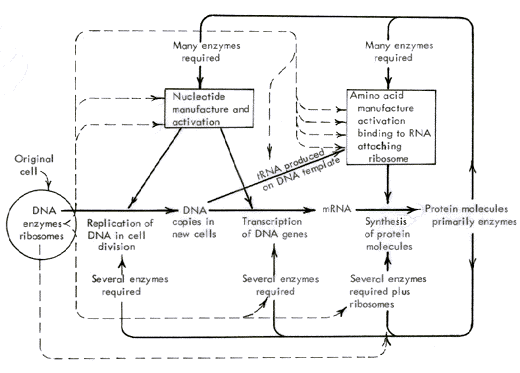RNA in the Synthesis of Proteins
1. The four nucleotides--A, U, G, and C--contained in the mRNA chain serve as letters
in a special alphabet. The letters of this alphabet are used in a code which contains
three-letter words called "codons." Using a four-letter alphabet, there are
4x4x4 = 64 possible three-letter words or codons. Scientists have established that of the
64 possible codons, 61 are codes for particular amino acids of the 20 amino acids used in
proteins. The remaining three codons serve as "stop" signals. Thus for each of
the 20 amino acids there are from one to as many as six codons. The genetic code is
therefore said to be redundant, because some of the amino acids are coded for by more than
one codon. It might be asked why this is. One value of this redundancy is that it provides
for more accuracy in the production of protein molecules. This is because a number of
possible slight mistakes in code transcription in going from DNA gene to mRNA to protein
will still bring about the insertion of the correct amino acid at the corresponding
position in the protein chain. It is like shooting at a target that has a larger
bull's-eye. This is certainly an intelligent use for the excess information capacity of
the code (61 codons but only 20 amino acids). This intelligence in biology supports the
view that an intelligent Mind conceived the genetic code and implemented the conception in
the original creation of the kinds.
2. If we examine our sample portion of an mRNA molecule and compare the nucleotide
sequence with the codons for the different amino acids, we will find that it contains
three codons for three different amino acids:
| | | |
| A - U - A | G - C - C | A - U - G |
| codon for | codon for | codon for |
| isoleucine | alanine | methionine |
Thus this sequence of nine nucleotides in the mRNA molecule codes for the insertion in
a protein molecule of the three amino acids isoleucine, alanine, and methionine, in that
order.
3. But how is the coded information in the mRNA molecule actually translated into a
newly constructed protein chain? The answer to this question has now been developed in
considerable detail. This translation is accomplished by a complex and very efficient
process involving the action of many very complex and highly specific enzyme molecules,
which are also protein molecules that are themselves coded for in the DNA of genes and
were constructed by the very same process of translation from mRNA to finished protein
molecules.
Before continuing our story of protein synthesis, let us take an overview of the
sequence of processes which leads from the DNA in a cell to DNA in new cells to mRNA to
newly constructed protein molecules. In Figure 4-10 the complex network of these
interdependent activities in living cells is portrayed graphically. Observe that this is a
kind of manufacturing flow chart in which all of the stages fit into a cyclic system. All
stages are dependent upon other stages. DNA is required for the manufacture of protein and
protein is required for the manufacture of DNA. In fact, protein molecules (enzymes) are
required in every one of the stages. Yet the design information for construction of each
enzyme is stored in the DNA molecules.
If in Figure 4-10 the "original cell" on the left is taken to be a fertilized
egg cell, it too must be furnished with a great deal of equipment if embryonic development
is to proceed. A fertilized cell has a complement of mRNA molecules, ribosomes, amino acid
molecules, several dozen different kinds of enzyme molecules, at least 20 kinds of tRNA
molecules and at least 20 kinds of aminoacyl-tRNA synthetase molecules, plus vital
structural arrangements in the cytoplasm of the cell. Without this equipment on board, the
fertilized cell will not produce life, for the equipment is required for DNA replication,
transcription and cell division to occur.
Moreover, DNA, mRNA, and enzyme molecules, are very complex, large molecules. The
average protein molecule is a chain of 200 to 600 amino acid residues which is coded for
in one gene in the DNA molecule in a chromosome. Since the codon for one amino acid
consists of three nucleotide "letters," the average gene contains 600 to 1800
nucleotides. Some enzymes are much larger than the average. For example, the two enzymes
which superintend the replication of DNA and the transcription from DNA to RNA, called DNA
polymerase and RNA polymerase, in prokaryotes contain about 1,100 and 4,700 amino acid
residues, respectively. RNA polymerase is particularly complex, consisting of six separate
amino acid chains. These six chains fold up into unique shapes and then fit together to
form the complete enzyme molecule.

figure 4-10. Flow chart, greatly simplified, showing the
interdependent factors involved in replication of DNA, transcription to RNA, and
translation of the genetic code in the production of enzymes (protein molecules).
|


